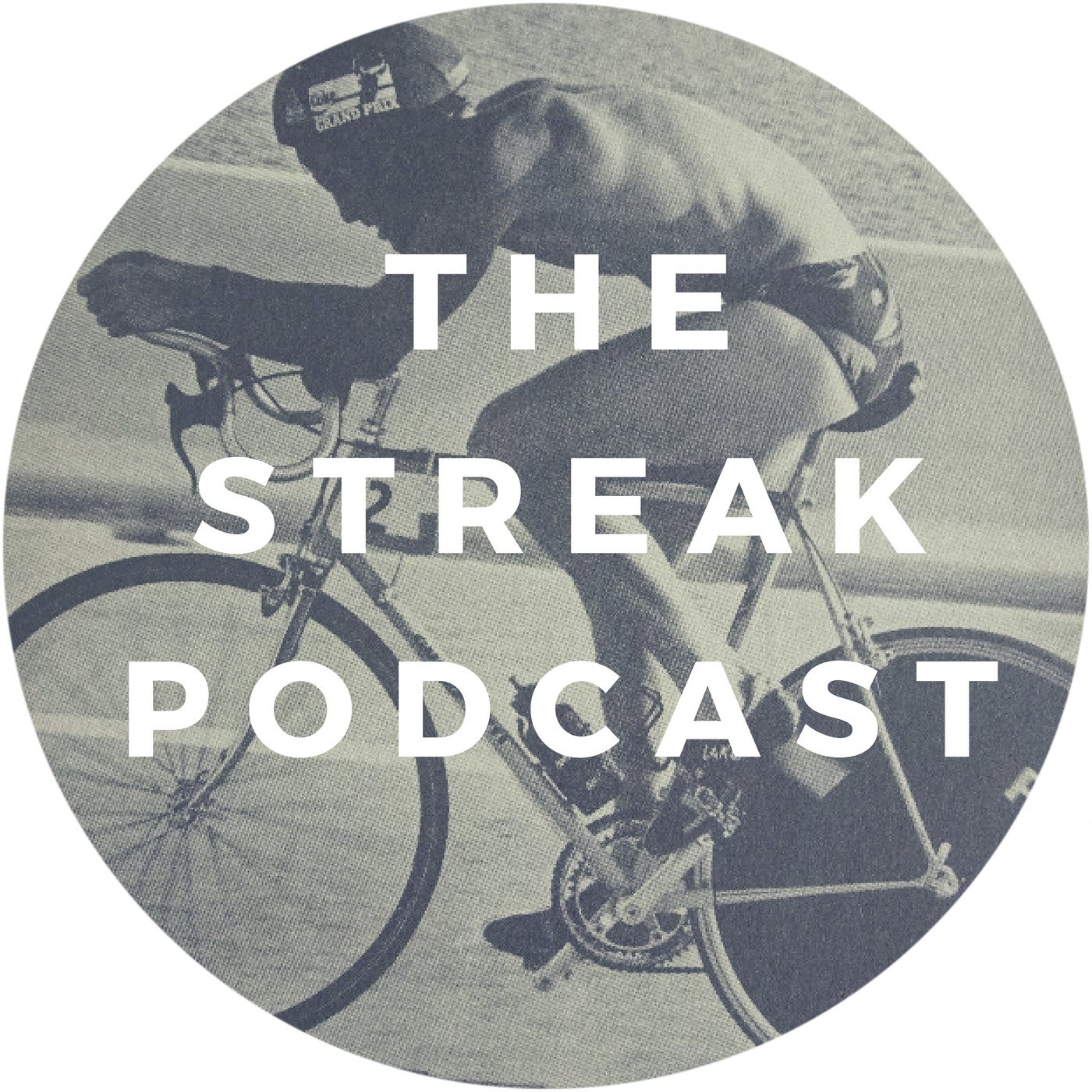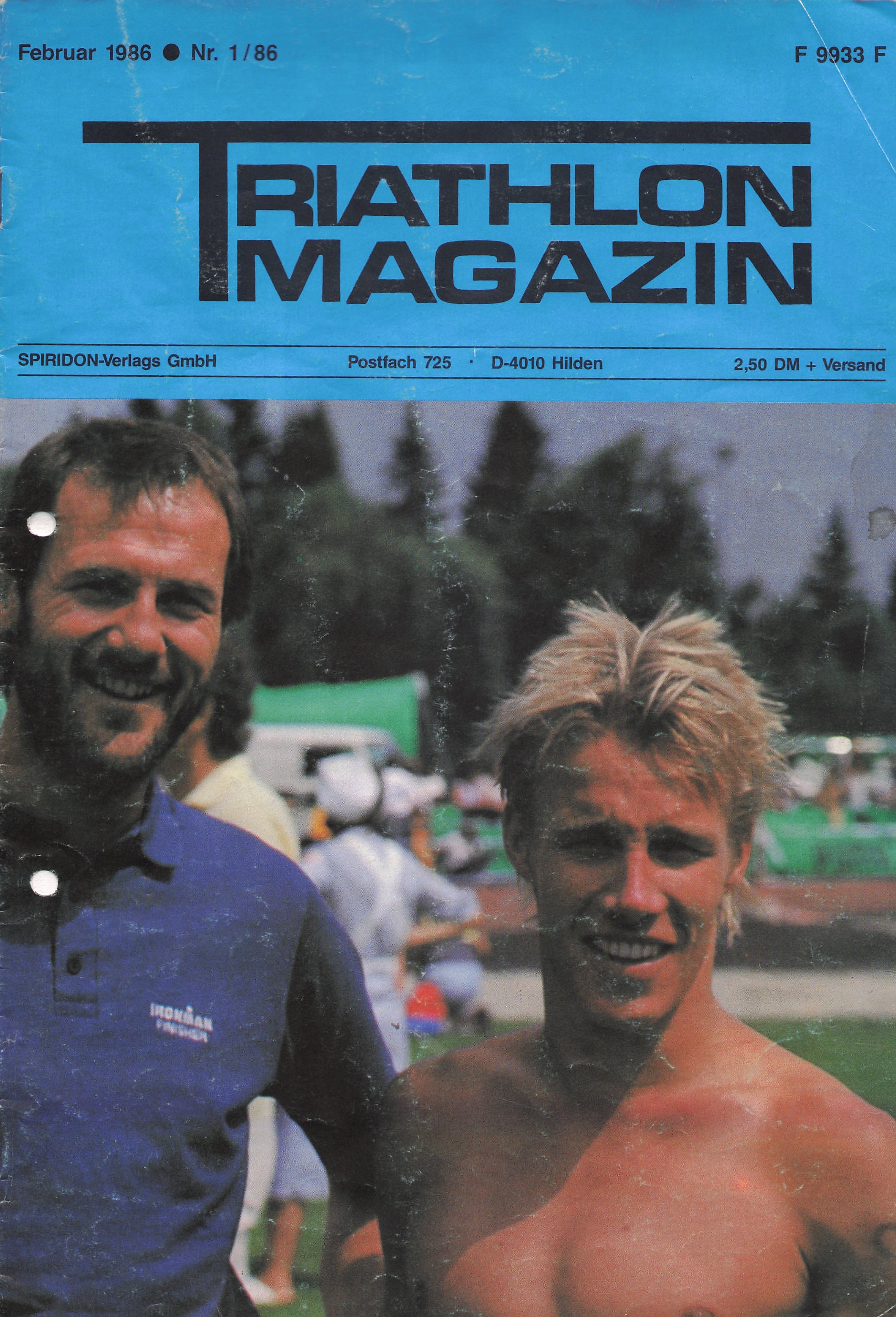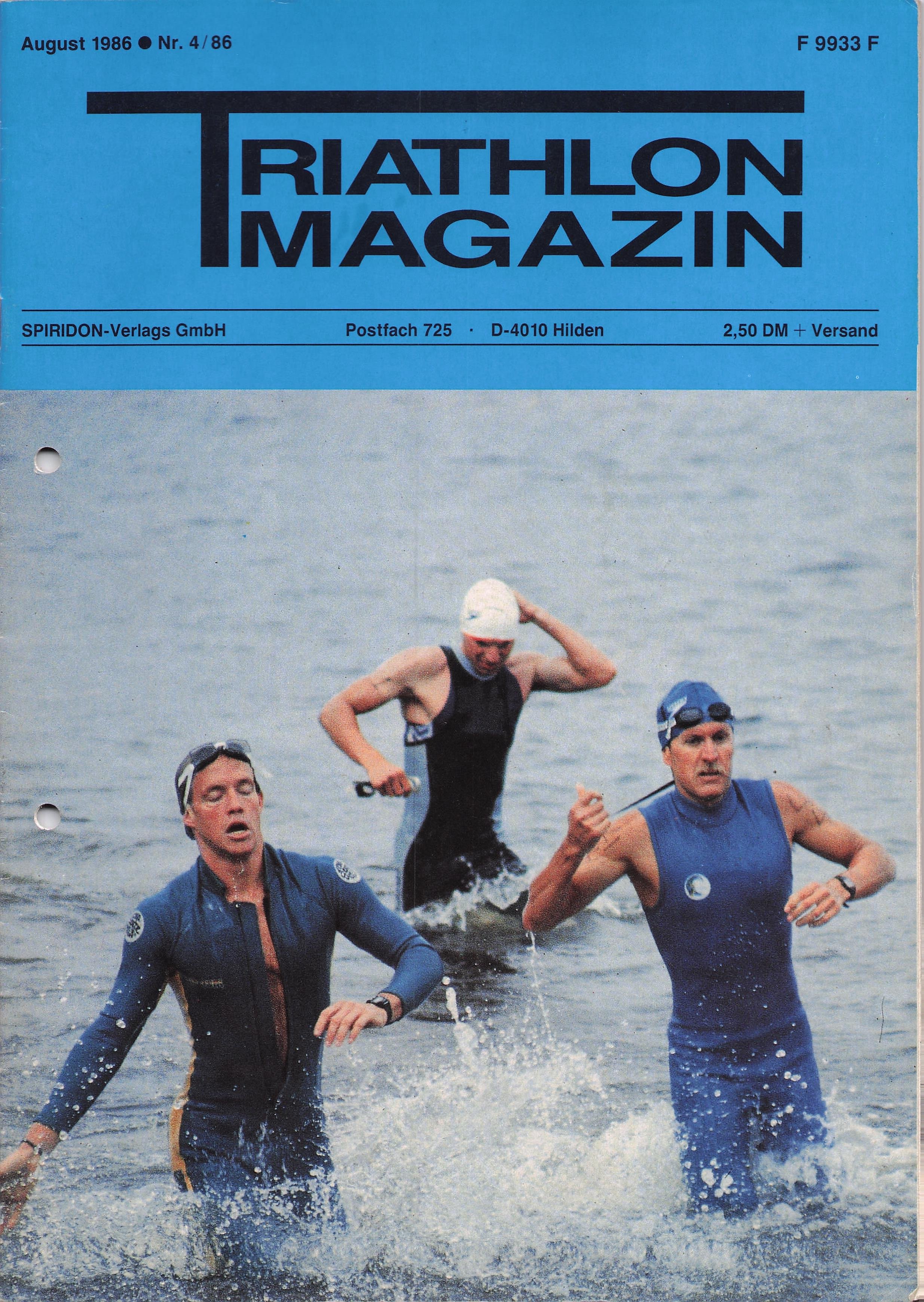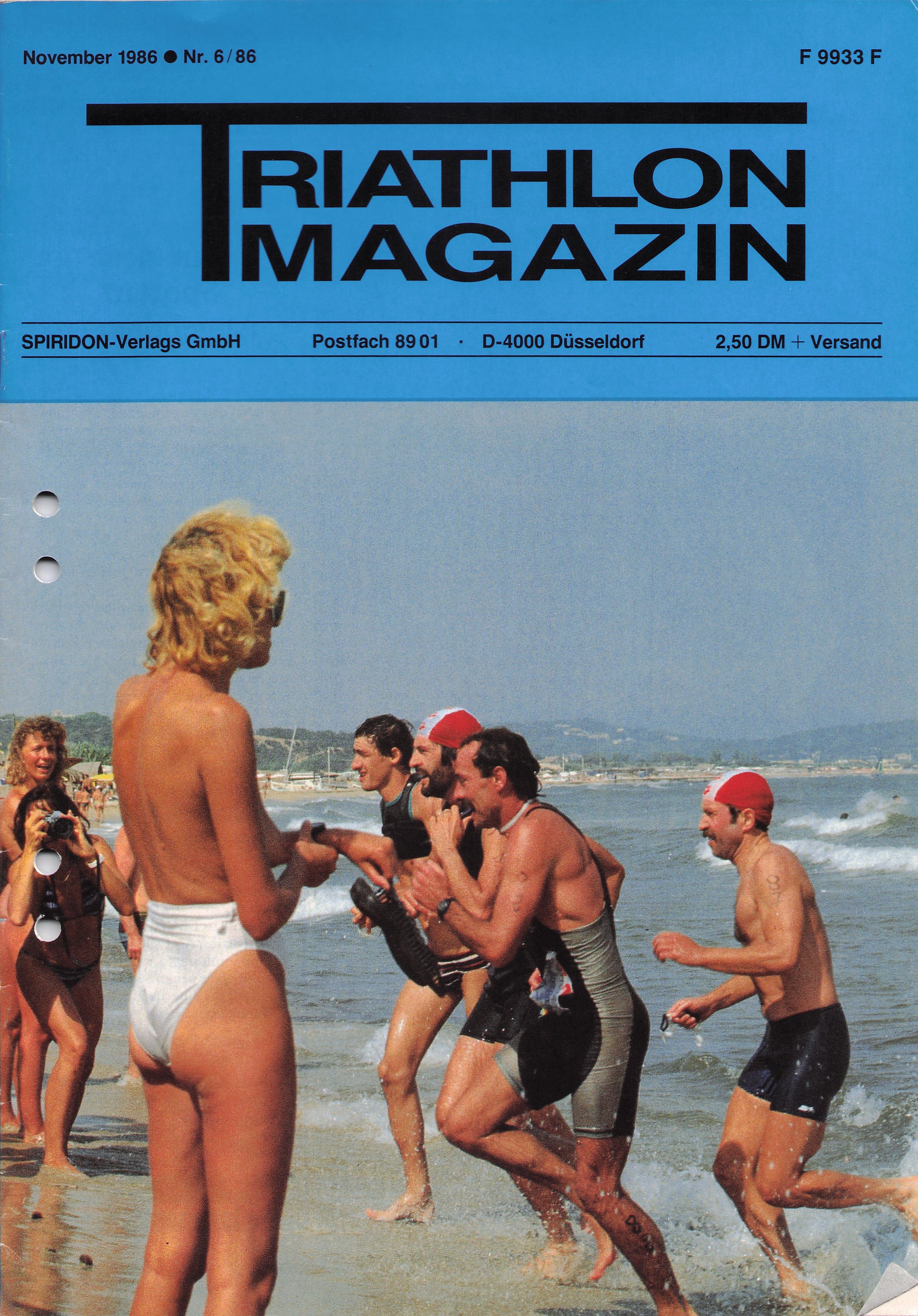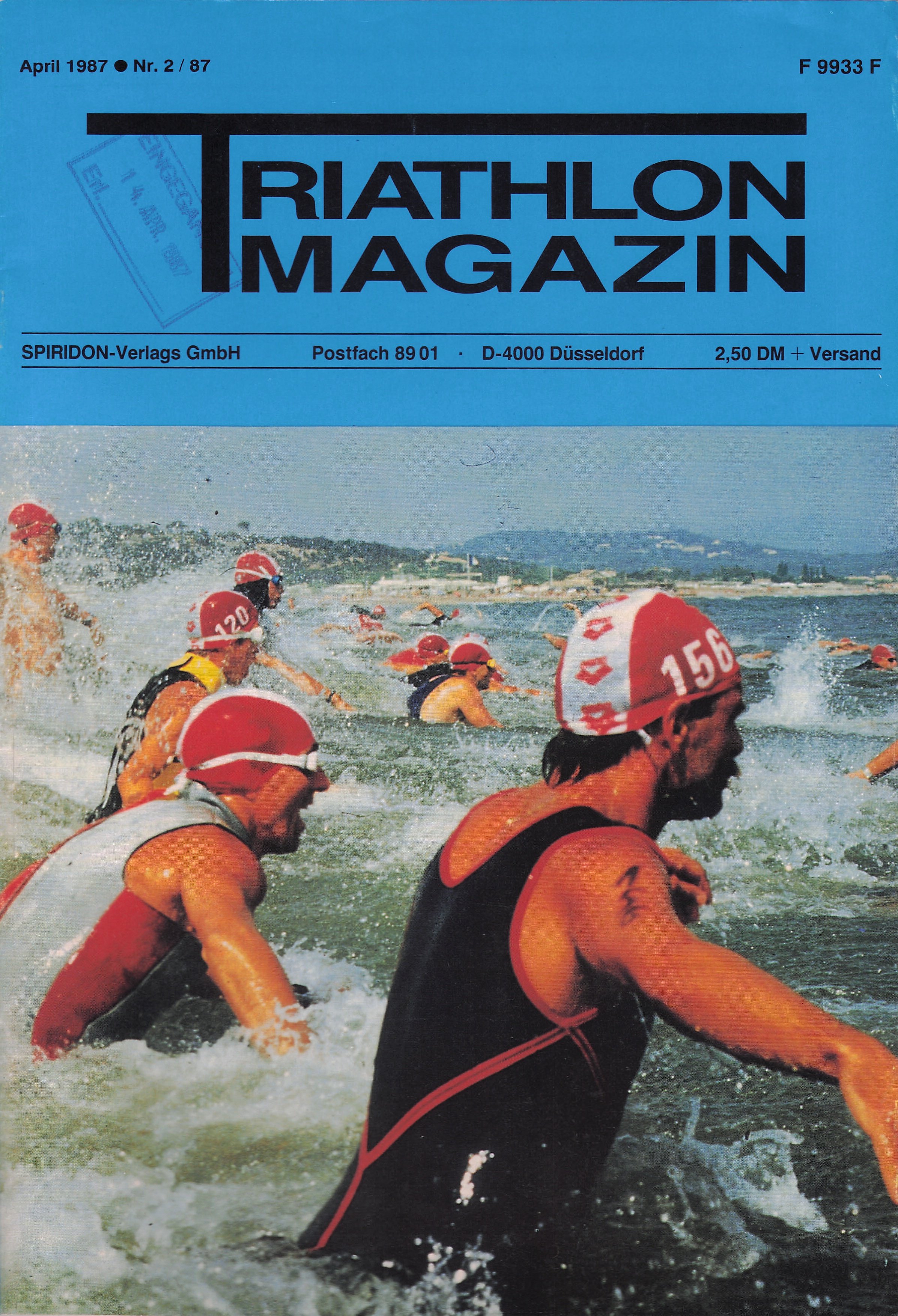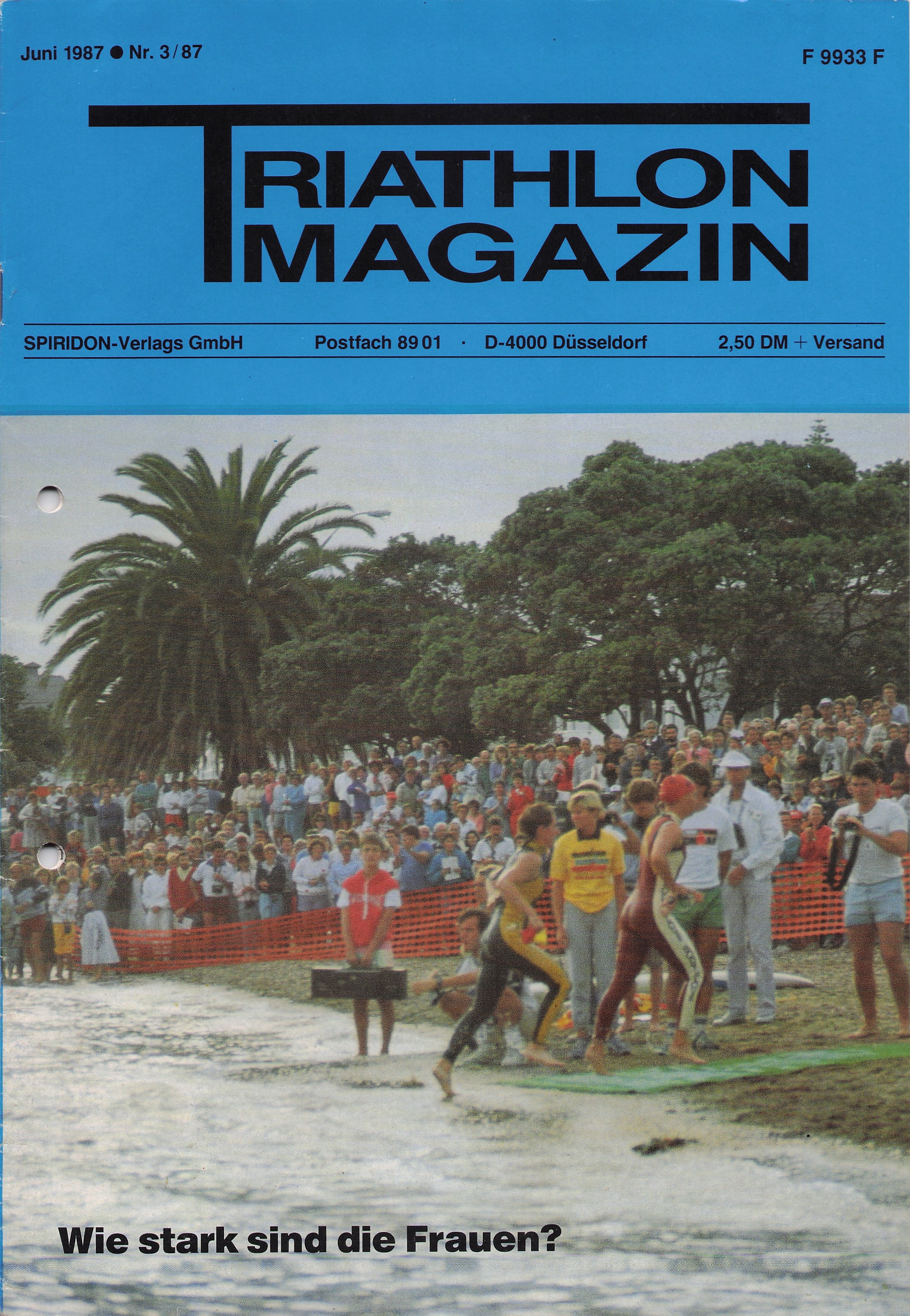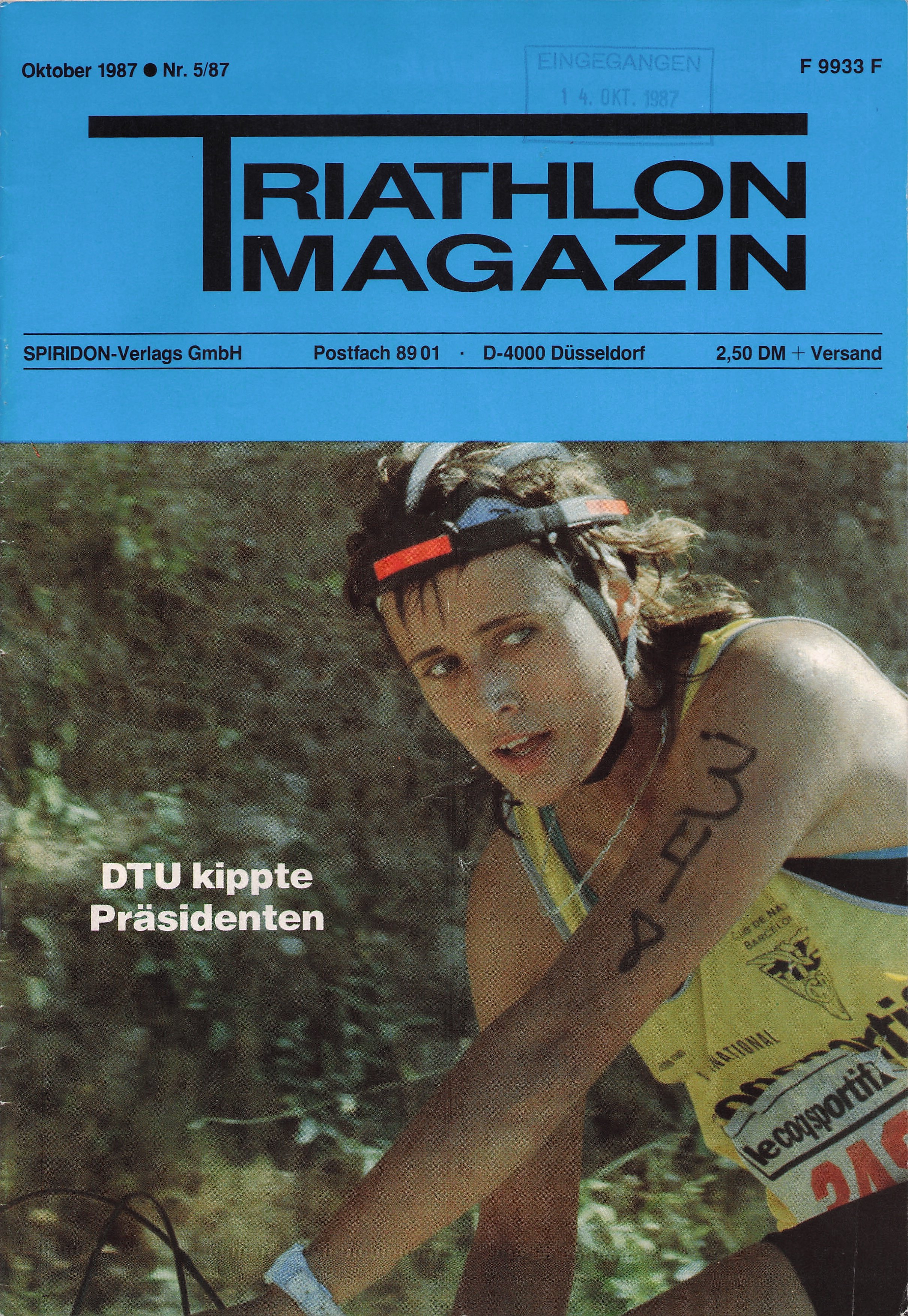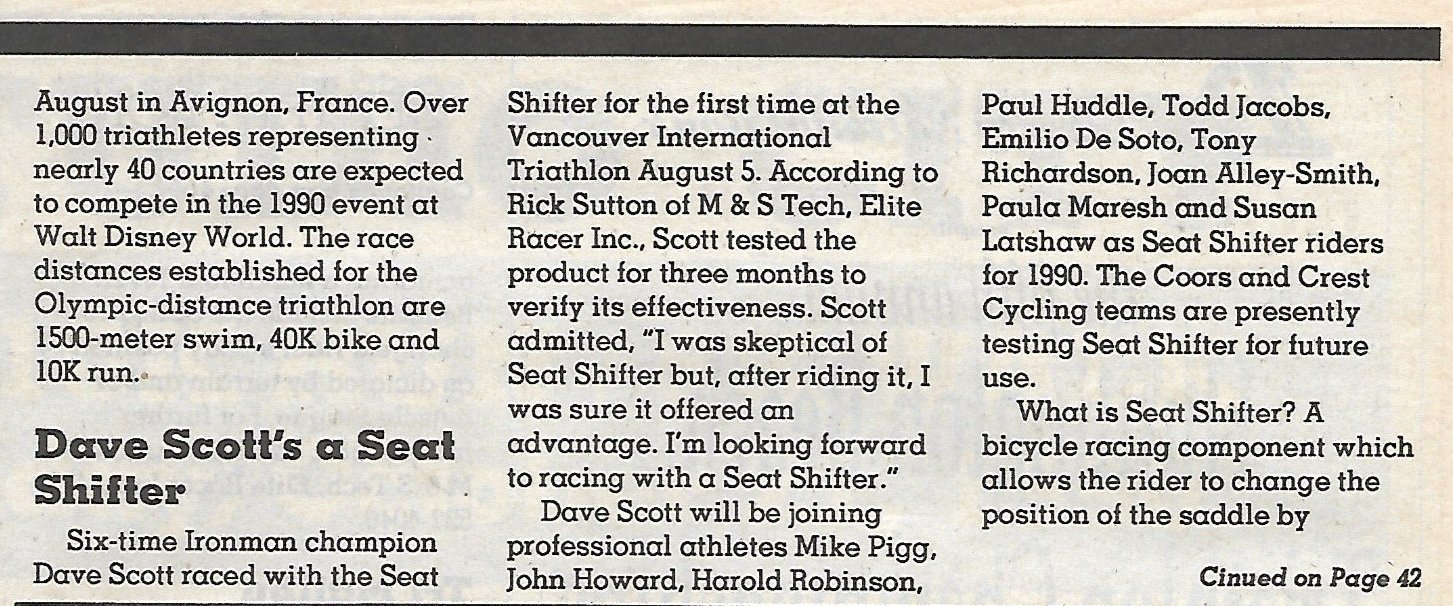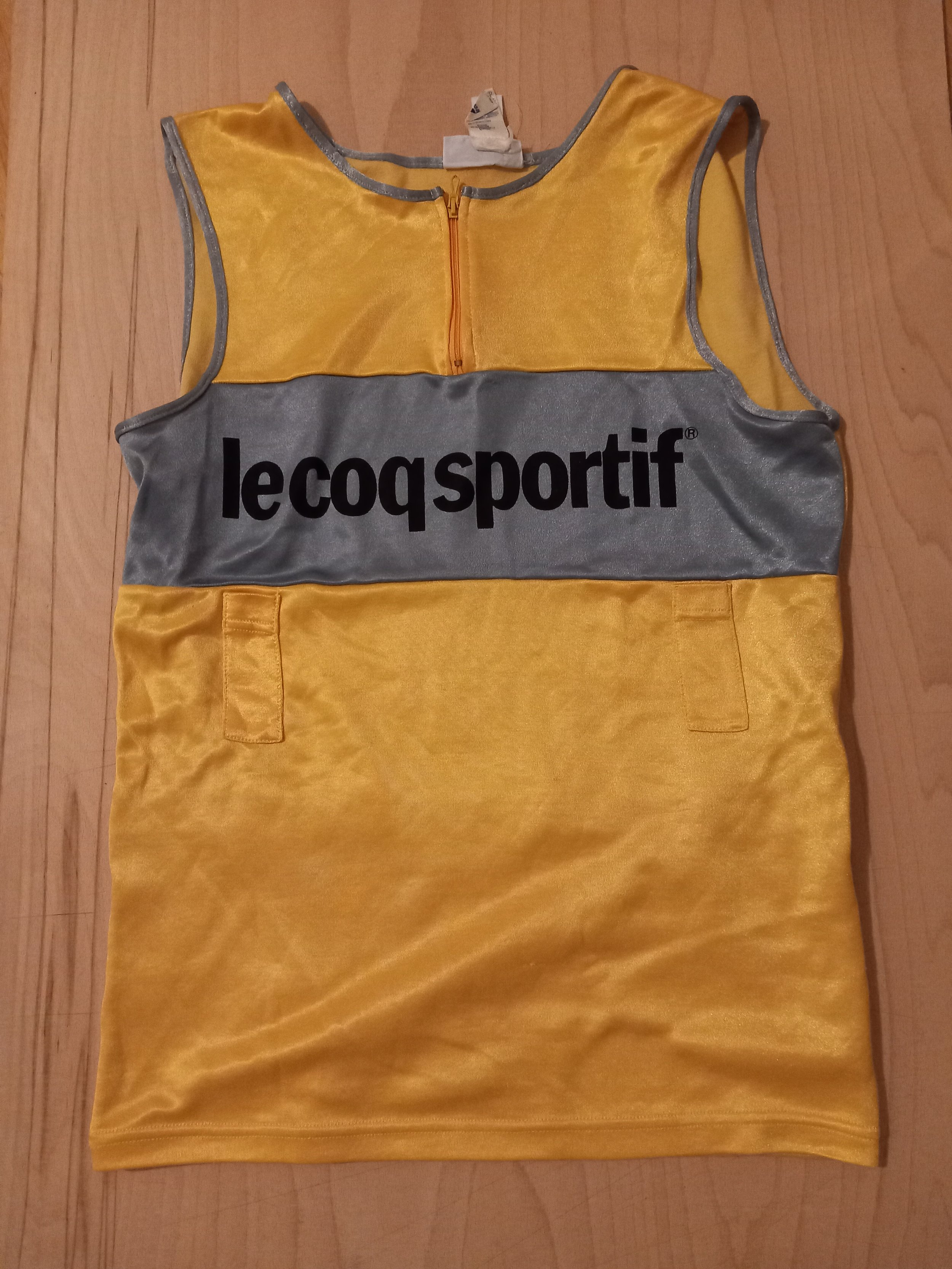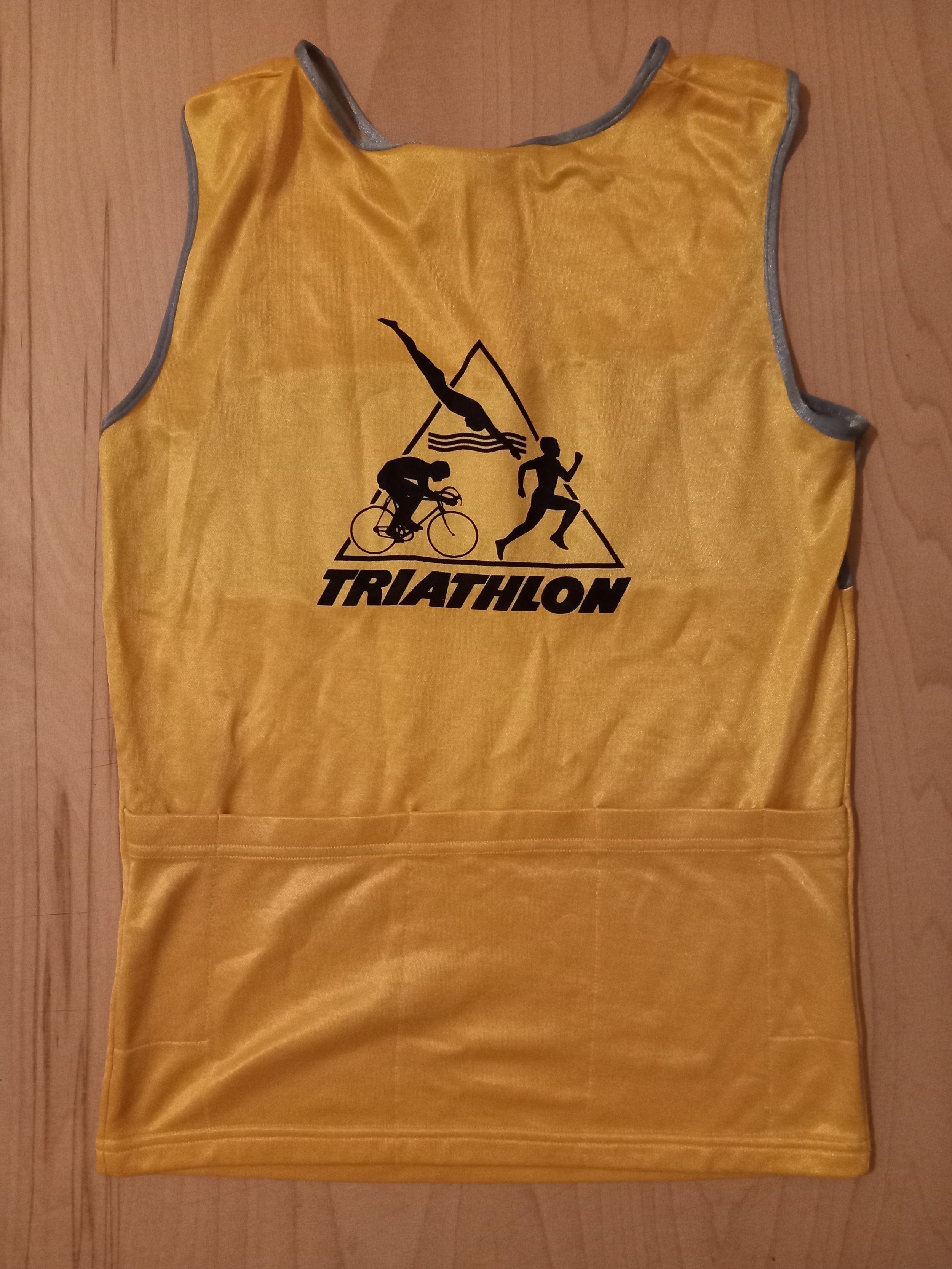Mark Allen At The 1986 Hawaii Ironman
I’ve already done a post about the 1986 Triple Crown. But here’s some more stuff about Mark Allen at the Hawaii Ironman in 1986.
In fact it’s my first request post from a reader. Let me know if you’ve got a fetish race, athlete or period that you’d like me to research. Or join me on a podcast to dive deeper into the subject.
Mark got 2nd at Hawaii in 1986. Although he showed up only two days before the race. He wasn’t really supposed to be there. As he’d planned to focus on Nice. After too many disappointments in Kona.
Although Nice always offered good prize and appearance money, Hawaii was offering prize money for the first time in 1986. So after winning Nice two weeks earlier. And feeling good. Mark decided to tackle the Ironman too.
I like the Bell Stratos helmet. The Eyeshades. The Lake shoes. The Nike kit. Obviously. The Coke bottle behind the saddle. And the low-pro bars. Most pros wouldn’t be on Scott DH bars until May 1987.
Oh. And there’s a bonus photo of Dave below. Because it’s so good.
Images: Tri-Athlete (FR) Jan-Fev 1987
Fresh Brew
From 1990 until 1992 Robin Brew was sponsored by Fresh Brew Tea. We mentioned it in TSP14. I also spoke a lot about Robin in TSP9. What a link up. Robin Brew. Fresh Brew. I’ll get in touch with Robin to find out more about how the deal got done. Then post the info here.
Anyway. Although he was minimally branded in 1990. See Emberton Park photo below. He had some pretty cool kit and equipment in 1991. InSport. Quintana Roo. Grip Shift. Hed. Scott DH bars were a rare choice in 1991 however. As most athletes were on clip-ons by then.
The 1991 photos I’ve included below are from the St. Croix Triathlon. The first ever round of the ITU World Cup. Back when it was still draft-free. And let’s take a moment to remember how good the photography and race coverage was from John Lillie and 220 magazine.
In 1992 Robin’s sponsor was Ty-Phoo Tea. Guessing this brand was part of the Fresh Brew group. He was also now on a Serotta with Syntace bars. By 1993 the tea was gone and Robin was sponsored by Trek.
1992 European Short-Course Championships
The 1992 European Short-Course Championships were in Lommel, Belgium on 5th July. Simon Lessing was the defending champion. These were the non-drafting but we-are-actually-kind-of-drafting days. Except for Spencer Smith. He was pumping away off the front on his beam-bike.
There was no internet back then. So my source for results was the Tuesday editon of The Daily Telegraph. I was pretty stunned to read about the GBR podium-sweep. It certainly motivated me to keep training hard and improve my placings in the second edition of 220 Triathlon Series.
I really thought Cook’s career was heading slowly downhill at this point. But I certainly didn’t have the courage to tell him that the next time we met up for the Wednesday ride. Next to the post-box outside the Eastbourne Campus of the University of Brighton.
Three weeks after Lommel he won the European Long-Distance Championships in Finland. Probably his second best career result after Avignon. I recently got hold of the 220 with the report in. Blog post coming soon.
1992 Embrun Olympic Distance Triathlon
The Embrunman is still on my bucket-list. The goal would be to just get fit enough one year to enjoy a long day out in nature.
The Embrunman Triathlon was started in 1984. The distances the first year were 750m/30km/10km. Then increased to 1500m/70km/21km in 1985 and 4km/132km/42km in 1986. In 1987 they moved closer to the ironman standard with 5km/180km/42km. Seriously. 5-clicks of swimming!
They stuck with the same distances in 1988 before settling on 3800m/180km/42km in 1989. Finally the Col d’Izoard was first used in 1990, creating the super-tough course that is still used today.
They added an Olympic Distance race in 1988. In the 1989 race Yves Cordier had a bike crash which put him out of the first ITU Short Course World Championships in Avignon. He would have been one of the favourites. Instead he did some commentary for Canal+.
In 1991 the ITU launched their World Cup Series. The races were draft-free back then and Embrun was a stop on tour in 1991, 1992 and 1993. By 1997 the World Cup Series was draft-legal but Embrun was back on the docket.
Since 1990 the race has always been held on 15th August as it’s a French public holiday. Here’s all the Olympic Distance results.
I raced it in 1996 in the middle of a hectic Grand Prix season. It was something like my 15th race of the year. I swam and climbed well and descended and ran not so well. The following week I was on antibiotics with a throat infection. They worked though, as I had a solid September.
The article below about the 1992 Embrun Olympic Distance Triathlon is from the October 1992 issue of 220 Magazine. It’s written by founder and editor John Lillie. The race was one of the many Spencer Smith and Simon Lessing head to heads from the early to mid-1990s.
Images: 220 (UK) October 1992
Looking through my archives shows me that Simon seems to have come out on top most often. But Smudger had a few significant victories, including the 1993 Worlds in Manchester. Here in Embrun Spencer found the long, steep climbs and technical descents pretty tough.
Check out Scott Molina’s Lightspeed. You can see that he sometimes switches the GripShift from the tri-bars to the drops. He won the long-distance Embrunman the year before. He had a year-off triathlon in 1993 and then came back in 1994. Even returning to France to do the 1994 Iron Tour.
Triathlon Magazin By Spiridon
I picked up these 6 copies of Triathlon Magazin on eBay Kleinanzeigen recently. Triathlon was a German language magazine published by Spiridon Verlag between 1985 and 1997. From 1998 onwards the triathlon content was absorbed into Spiridon. The famous running title.
The French language running magazine Spiridon was launched in Switzerland in 1972. The goal of the magazine was to encourage running for fitness.
Images:
Triathlon Magazin (DE) Februar 1986
Triathlon Magazin (DE) August 1986
Triathlon Magazin (DE) November 1986
Triathlon Magazin (DE) April 1987
Triathlon Magazin (DE) Juni 1987
Triathlon Magazin (DE) Oktober 1987
Soon the readers of the magazine started to form Spiridon Running Clubs. In Germany, France, Switzerland, Belgium, Italy and Canada. These new clubs also got involvedd in the organisation of local races.
A German language version of Spiridon was first published in 1974 by journalist and 1972 Olympic marathoner Manfred Steffny. His brother is two-eleven marathoner Herbert Steffny.
In 1975 one of the Spiridon founders, Noël Tamini, combined with Jean-Claude Pont, the race director of Sierre-Zinal*, to start the Coupe Internationale de la Montagne (CIME). Their objective was to promote international mountain and fell running competition.
I’m not sure if any of the Spiridons are still going. More research is needed. But there seems to be a cool tribute site selling merch.
I’ve found some super-articles in Triathlon. About the 1986 and 1987 Le Coq Series. And some triathlons close to me. Munich. And Bodensee. I’m also using the magazines to continue to work on my German.
*The first edition was in 1974.
Bike Nashbar
Here’s the Spring 1988 Bike Nashbar catalogue. @oldtriathlonstuff and I used to read it like a work of Shakespeare.
Our Mum cut the hair of a woman who had a daughter in the states. She’d organise drops of bike and tri related documents. Like Kim Philby.
French Race Calendars
When I’d finished reading everything in the Michael Hardcastle canon. Titles such as Away From Home, In The Net and Davey Must Score. These French race calendars became my bedtime reading.
I couldn’t speak French back then. But I’d use the key on the first page to work out the distances and the importance of the race. And then I’d spread out a map of France to locate the regions and towns.
My mum would call the race organisers to get entries for me and my brother. Then there’d be a few weeks wait as stamped-addressed envelopes and money-orders were exchanged. Always seemed to work though.
Ripley Bike Jumble
In April 2022 I was visiting the UK with the family and my brother took me to my first bike jumble. Life-changing. I need to go to more.
It was at Ripley. The Kona of bike jumble venues. And a town steeped in cycle touring history. As a stall-holder explained to me. At length.
There were about 20 stalls outside in a school car park. And then another 10 or so inside. We nearly missed those though. I only spotted the sign for the sports hall while queueing for a bacon sandwich and a coke.
Luke bought some Profile Sonic Strykes, a Vitus 979 frame and a Shimano 105-5 group-set that he put on his Dave Russell vintage tri-bike.
I found some Shimano Dura-Ace 165mm Square Taper cranks for my son’s bike, two Carradice saddle bags and three copies of Winning magazine.
I’ve got five Carradices now. It’s how I like to carry stuff. Training, touring and racing. I’ll try and make a quick film about them.
Winning was started by Jean-Claude Garot in 1983. Garot also owned all the Tri-Athlete titles in the 1980s. Here’s a podcast episode about the history of Tri-Athlete and some early-UK titles. And below are some ads for
Tri-Athlete subscriptions that I found inside.
The Seat Shifter
Here’s the Seat Shifter. Which really was a 1990 phenomenon. There weren’t many around in 1991. Did the company close? And sponsorships end. Or did athletes not think it gave them a sufficient speed advantage for the time lost due to the weight of the device? More research needed.
I know they used to break though. When I worked at Perfect Performance we had a big box of returned units in the corner of the office.
The Seat Shifter was essentially a spring-loaded sliding system that allowed you to pull a lever on your handlebars and change your saddle’s for-aft position while riding. Further back for climbing. Forward for riding hard on the flat. At least that was the theory. Of course, this would also create small changes in saddle height.
Images: Competitor Magazine (USA) September 1990
The most visible user was Mike Pigg. The video below is the 1990 Nice Triathlon. You get a few glimpses of Pigg and the Shifter.
And although Dave Scott featured in the article and the advertisement above. He didn’t use a Seat Shifter at Nice.
Triathlete (FR) did a product review of the Seat Shifter in July 1990. it’s below. I’ll do a quick translation tomorrow morning.
There were also plenty of non-moving alternatives to get your saddle further forward in 1990. I’ll present some of those soon.
And let’s not forget the Seat Leash! That definitely needs a post.
Images: Triathlete (FR) Juillet 1990
Scott Tinley’s Quiz
Just did it. I got 31.
Answers are here. Write your score in the comments. No cheating.
1989 Triathletes Of The Year
I’ve already looked at the 1986 and 1988 Triathletes Of the Year. So here’s 1989. Mark Allen this time. And Erin Baker again. Both raced 10 times and won 10 times that season. Note that Triathlete Magazine’s most important criteria when making their selections was:
Performance at major international events of all distances.
There’s a bit of a renaissance of this. Knibb, Iden, Charles-Barkley. Blummenfeld. After many years of elite athlete specialisation.
I’m definitely going to have the Best Season Ever debate on here one day. Mark Allen’s and Erin Baker’s seasons below are contenders.
I also rate Simon Lessing’s and Karen Smyers’s 1995 seasons. Lessing won short-course worlds, long-course worlds and the Iron Tour. Smyers did the short-course worlds / Kona double. Like Allen in 1989.
Images: Triathlete (USA) March 1990
The 1984 Coolangatta Gold
The July 1984 issue of Triathlon magazine tells the story of the first year of the Coolangatta Gold Surf Life-Saving event. The race was actually invented to facilitate the making of a film.
Only the trailer and a few clips are on YouTube in English. Oddly, the full-film is available in German!
Images: Triathlon (USA) July 1984
Reading this article motivated me to do some more research. About Guy Leech. Who they call Craig Leech in the article! And the Surf Life-Saving scene in general. It looks great. Especially the Nippers programmes.
I’d like to get involved in the sport. But Munich is somewhat land-locked. I’ll investigate. I was at university with a guy who competed. From Devon. Or Cornwall. He trained with the triathlon club because he also needed to run. But did all sorts of weird underwater stuff during swim sets.
It’s got me thinking about the future of triathlon. And getting events away from roads. Keeping the race self-contained near a beach, in a park or around a swimming pool. Really short distances. Linking swim, bike and run multiple times and in different orders. Heats and finals. Sign me up!
Rick Wells Visits Your School
This is exactly what I wanted to happen after reading this article in Tri-Athlete (UK) in 1988. To replace my piss-poor PE teacher for a day.
I’m not sure if the French version was a direct translation of what I first read. But I’ve got a free period. So here goes. Note. There are few lines in there that are of it’s time. Maybe. Don’t cancel me.
Education and Promotion in New Zealand: Break-Time For Wells!
Making triathlon a sport for all is maybe the near-impossible goal of all the European and american federations. But in New Zealand they’ve done it.
Around Auckland triple-fitness enjoys an unexpected popularity. Nobody is surprised to see a group of cyclists training on Scott DH bars. And even the elite athletes take part in a few low-key local races every year.
The trendy people go to parties in finisher’s t-shirts. And try not to be embarrassed when asked if they wear a wetsuit when the water is below 20°c? Or. Is riding a fixed-gear bike is essential for winter training?
Images: Tri-Athlete (FR) Juin 1988
The secret of this popularity is the tight collaboration between sponsors and the media. Nearly everyday TV shows commercials with Rick Wells promoting cereal bars or a brand of beer. In New Zealand all the breweries get involved in sport sponsorship. Add to that, in the last few years a major international triathlon has been professionally organised. Publicity for the event includes poster campaigns in downtown Auckland and mobile billboards. As well as an hour of prime-time TV coverage.
Triathlon in New Zealand also has two exceptional representatives. Erin Baker and Richard Wells. Who can be thanked in large part for the success of the sport in their country. Wells is a role-model for many young people. Of an unknown athlete. Getting involved late in the sport. But who needs only three years to become world champion. A title he won on enemy territory in Perth in January 1987. This made him a national hero, worthy of extraordinary amounts of publicity. Baker received the same honours after her victory at the Hawaii Ironman in October 1987.
However, the Kiwis are not just relying on their current talent. They’re already preparing the future. With policies based on developing the amateur side of the sport and working juniors triathletes.
Woah! Did you see the world champion?
At 09:25 in the morning in the New Zealand countryside. At an abandoned crossroads a single building is at the centre of a large courtyard. Old pieces of sports equipment lean against the walls. Appearing to hold them up. You need a good imagination to guess that a school is behind the ruins.
At 09:30 about 20 children rush shouting from the classroom and play for a few minutes. Until their teacher brings back some order. She has an old-school teacher look. Hair in a bun. Round glasses. Stern face.
On her signal all the kids sit on a bench in height order. From the oldest. Teenie, age 13. To the youngest. Benjamin, only 2 years old. All the children attend the same school. The youngest are barefoot and the oldest wear gym shoes and t-shirts with the face of Madonna on.
Today is a different type of day. A big day. The man getting his bike out of his car and putting it together expertly is a hero around here.
Richard Wells, triathlon world champion, approaches the group smiling and greats them with a playful “Hi!”.
“Wow! it’s really him. I can’t believe it!” the young girls exclaim together. As one of the younger students asks the teacher if it’s really the guy from the posters. You never know.
Rick’s on a mission. To introduce his sport to schools around the country. Although in villages even more rural than this one there’s a growing enthusiasm for the sport. The absence of initiatives, facilities and equipment make taking part triathlon difficult.
Wells is trying to solve the problem by instilling the basics. In all of the four schools that he visited today, the programme is nearly the same.
He starts by introducing himself. An eternal moment for the young girls who shoot him with loving glances. The boys don’t show much interest in Rick’s career. They’re more into his bike. How do you hold the Scott DH bars? Why is that position so aerodynamic? Rick explains but hardly anybody is listening. Most of the children are picking their nose.
Then. Why do you need so many gears? It appears that the class has preapared for Rick’s visit by working on their questions in advance. And will no doubt form the contents of their next essay.
Over the next 20 minutes the ice is slowly broken until none of them hesitate to try holding the bars, sit on the saddle or squeeze the tyres of Rick’s bike. A big kid even slaps Rick on the back and congratulates him.
A young girl is particularly interested in his cycling shoes and clipless pedals. She clips them in. Unclips them. And then disappears with one of the shoes. Here, like everywhere else such a trophy is priceless.
Rick’s irresistable charm has definitely created a relaxed atmosphere. And the children collapse laughing when he explains how he saves time by urinating in his shorts. Or when he explains the technique of sucking like a baby on a bike bottle while cycling.
These simple school visits establish a contact between the champion and his fans. The children discover the human side of the sport and it’s secrets. With this information, they too could one day become kings of triathlon.
Tinley Take-Aways
Here’s three interviews with Scott Tinley. Tri-Athlete in July 1984, Triathlon in Oct-Nov 1984 and Triathlon in Jan-Feb 1986. The second interview is with Tinley and 1979 Hawaii Ironman winner Tom Warren. Tom was slash still is a huge San Diego triathlon pioneer slash personality.
Warren has a YouTube channel. And Tinley is occasionally on Instagram.
You can learn more about Triathlon and Tri-Athlete in TSP5. I also spoke about Tinley clothing in TSP12. And I urge you to read two of his books. Scott Tinley’s Winning Triathlon. And Triathlon: A Personal History.
Here are my take-aways from the three articles. In list form. Also. How good was triathlon writing back then! The dialogue. The drama.
Tinley was probably the first athlete to build his brand. He had the cool California look. And he did confident yet funny self-promotion. Then came the clothing brand. Merch!
When Scott Tinley and Dave Scott were swapping Ironman titles in the early-80s, Tinley’s wrote “Beat Dave Scott” on his paddles.
Tinley maintained several side-hustles while he was gradually turning triathlon into a full-time job. Fire Fighter. Marina manager. Lifeguard. And marketing trainers at Second Sole.
Like all the athletes back then, Tinley raced a lot. And mixed up short and long. In 1985 he raced 23 times. Probably 6 half-ironman or longer. And the rest around Olympic Distance.
Although Tinley was better at longer distances, he was a big supporter of the USTS races. He was asked to design the distances used in 1982 and 1983. And saw the short course as the best way to get more people into triathlon and promote the sport. High tides float all ships.
Tinley had other hobbies to take his mind away from the mileage. Listening to jazz. Playing his guitar. And making furniture.
Tinley was a member of the controversial J-David triathlon team. Yes. Yes. Will definitely expand on this soon. He had an office in their HQ and organised the racing and travel schedules for the athletes.
Tinley started racing triathlons in 1976 when he moved to San Diego. Back then you needed to know someone, who knew someone, to find out when and where races were taking place. A bit like 1980s Reading.
Tinley trained a lot. As triathlon back then was a physiological experiment and an adventure into the unknown. From this Tinley finished 3rd at his first attempt at the Hawaii Ironman in 1981.
The July 1984 cover of Tri-Athlete is one of the best triathlon magazine covers ever. Currently looking for a yellow base-layer.
1984 Almere Triathon
The first edition of Almere was held in 1983. It was started by Joop Van Zanten. He’d done the Hawaii Ironman in 1981. The race is also still going. And I did it in 2002. Great event. I’d definitely go back.
The first triathlon in The Netherlands was held in September 1981 in Kijkduin. It was pretty much an ironman. As the organisers had either seen the 1981 ABC coverage from Hawaii or read the 1979 Sports Illustrated article. Kijkduin is on the coast. But the swim was held in a 50m pool.
For context, the first triathlon in Europe was probably in Pilsen in August 1980. Pilsen is in the Czech Republic. But was in Czechoslovakia back then. It’s only a 3 hour drive from where I live. I need get over there.
Germany, UK and France didn’t have triathlons until 1982. In April in Essen. September in Reading. As a training race for those going to Nice. And November in Nice. All of these events pre-dated the formation of the country’s national triathlon federation. More info coming!
So here’s 1984 in Almere. The race had 351 starters. Including athletes from Belgium, West Germany, Switzerland, the UK and the USA.
Ardis Bow from USA won the women’s race. And Axel Koenders defended his men’s title. 2nd was Gregor Stam. He won that first event in Kijkduin. 3rd was Rob Barel. Kurt Madden from the USA was 4th.
But I’ve really posted this to highlight Koenders’ outrageous fairings!
Images: Tri-Athlete (FR) Juin 1985
Research And Development Dave
The Dave Scott Signature range of Centurions debuted in 1987. But Dave was hard at work starting in 1984. He had a lab coat, calipers and a security clearance badge. Maybe to get into the top secret Biopace zone.
Image: Tri-Athlete (USA) July 1984
Simon And Brad In Salon
I bought the August and September 1993 issues of Triathlete (FR) when I was over there on a family holiday and racing at Miramont de Guyenne.
The race was a round of the Grand Prix and the French Junior Championships. Not sure how I did. But seeing the speed of the juniors gave me plenty of motivation to train hard through the deep Slough winter.
Although I couldn’t read French at the time, I was intrigued by this article about Simon lessing and Brad Beven sharing a house. Like The Monkees. Or the Beatles in Help! I also thought the photos of Brad stabbing Simon in the back and then pulling his shorts up were pretty funny.
If I have time I’ll do a full translation tomorrow.
Images: Triathlete (FR) Septembre 1993
I’ve always wanted a J-Disc
Last year I picked up a Spengle disc wheel. Made in 1991 or 1992. It’s on the vintage tri-bike that I assembled. Here’s a video.
The first production discs appeared in triathlon in 1984. Mainly the Campagnolo Ghibli and the Mavic Comete. Steve Hed was also down in his basement in St. Paul working on something back then.
Here’s a photo of Mark Allen riding a Comete at the 1985 Avignon Triathlon. Yikes. This link is broken. I’ll try and fix it later. All my vintage next tri-bike build aspirations right there.
And here’s Scott Tinley talking about the Ghiblis. Check out all his kit and equipment photos at the Triathlon History Museum.
“The Campagnolo Ghibli 700c rear disc wheel was perhaps the first highly coveted (and largely unavailable) piece of cycling equipment in triathlon. There were precious few coming out of Campy Europe and the price in 1984 was between $2500--$3000. The wheels were re-cycled from European pro teams that used them in time trials. To show up on race day with one of these was a badge of accomplishment, skill, money, or connections. They were noisy and heavy but on a mostly flat course, much faster than a spoked-wheel. One of the many nuanced challenges was inflating them. This required a specially-fabricated L-shaped device to be fit onto the pump hose. It looked like a 70s hash pipe and there were times when customs agents had some hard questions for those of us who traveled with the adapter.”
But when I started pimping my Dave Russell in the early-1990s I wanted a colourful J-Disc. Like Mike Pigg. They weren’t carbon. Like the Campags, Mavics and HEDs. Instead a taught mylar film was bonded to a spoked wheel. So it was super-light and you could true it.
I even had a friend who made one in his dining room. Using a hair dryer and Super-Glue.
I Bought A 1986 Le Coq Sportif Vest
I got this on eBay. I wrote about Le Coq Sportif shoes and tri-suits here. It fits perfectly! So I’ll do a few races in it next year.
The quality is superb. There’s three large and two small pockets in the rear. And reinforced parts for pinning numbers on the front.
Images: Tri-Athlete (FR) Septembre 1986
Dirk Aschmoneit is wearing one at Embrun in 1986 above. And Glenn Cook at St. Croix in 1988. Below. Is he walking up The Beast?
Images: Tri-Athlete (FR) Juin 1988
